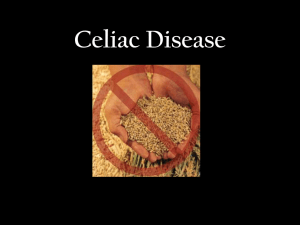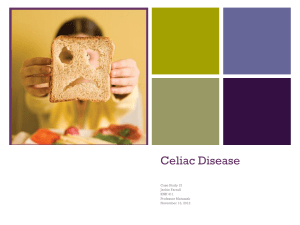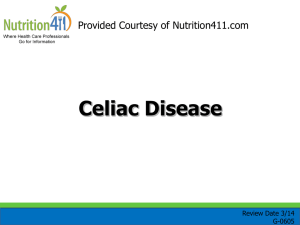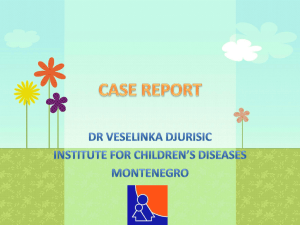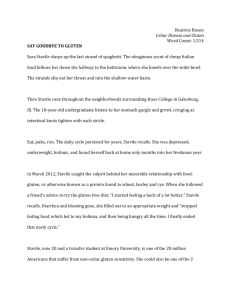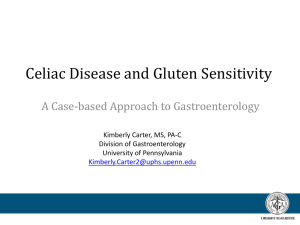Pathogenesis of Celiac Disease - FACS Nutrition and Food Science
advertisement
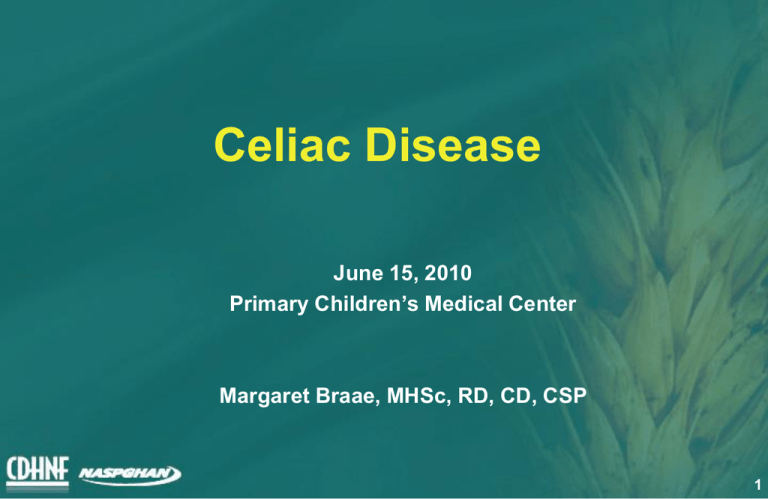
Celiac Disease June 15, 2010 Primary Children’s Medical Center Margaret Braae, MHSc, RD, CD, CSP 1 Definition • Celiac disease is an inherited, lifelong intolerance to gluten. • Gluten is the protein found in wheat, rye and barley. 2 Why do people get Celiac Disease? • Genetic predisposition • Exposure to gluten (environmental trigger) • Another trigger, such as illness, stress, other autoimmune disease Occurs in people of all ages Most common genetic disorder in N. America and Europe 3 Celiac Disease is: • A unique autoimmune disorder because: – both the environmental trigger (gluten) and the autoantigen (tissue Transglutaminase) are known – elimination of the environmental trigger (gluten) leads to a complete resolution of the disease 4 Celiac Disease Epidemiological Study in USA Population screened 13145 Healthy Individuals 4126 Risk Groups 9019 Symptomatic subjects 3236 Positive 31 Negative 4095 Prevalence 1:133 Positive 81 Negative 3155 Prevalence 1:40 1st degree relatives 4508 Positive 205 Negative 4303 Prevalence 1:22 2nd degree relatives 1275 Positive 33 Negative 1242 Prevalence 1:39 Projected number of celiacs in the U.S.A.: 2,115,954 Actual number of known celiacs in the U.S.A.: 40,000 For each known celiac there are 53 undiagnosed patients. A. Fasano et al., Arch Int Med 2003;163:286-292. 5 The Celiac Iceberg Symptomatic Celiac Disease Manifest mucosal lesion Silent Celiac Disease Latent Celiac Disease Normal Mucosa Genetic susceptibility: - DQ2, DQ8 Positive serology 6 7 Gastrointestinal Manifestations (“Classic” or “Typical”) Most common age of presentation: 6-24 months But anyone with these symptoms should be screened • • • • Chronic or recurrent diarrhea Abdominal distension Anorexia Failure to thrive or weight loss • Abdominal pain • Vomiting • Constipation • Irritability 8 Classic Celiac Disease 9 CD with Atypical Symptoms Non Gastrointestinal Manifestations Most common age of presentation: older child to adult • • • • • • • • Dermatitis Herpetiformis Dental enamel hypoplasia Osteopenia/Osteoporosis Short Stature Delayed Puberty/Infertility Peripheral Neuropathy/Ataxia Chronic Fatigue Normal weight or overweight • • • • • Iron-deficient anemia resistant to oral Fe Hepatitis Arthritis Epilepsy with occipital calcifications Behavioral with depression, poor school performance, irritability 10 Silent or Asymptomatic • Treatment with a gluten-free diet is recommended for asymptomatic children and adults with proven intestinal changes of Celiac Disease. • It is most commonly diagnosed in those who also have: – – – – Type 1 diabetes Selective IgA deficiency Down syndrome Turner syndrome – Williams syndrome – Autoimmune thyroiditis – A first degree relative with Celiac Disease 11 Diagnosis Diagnostic principles • Confirm diagnosis before treating – Diagnosis of Celiac Disease mandates a strict gluten-free diet for life • following the diet is not easy • Quality Of Life implications • Failure to treat has potential long term adverse health consequences • Increased morbidity and mortality 12 Diagnosis: • Blood Test • Endoscopy with biopsies • Complete resolution of symptoms on a glutenfree diet • Genetic testing available. – A negative predictor. That is: Much of the population carries the genes for celiac disease, but not everyone gets it. 13 Treatment • Only treatment for celiac disease is a gluten-free diet (GFD) – Strict, lifelong diet – Avoid Gluten found in: • Wheat • Rye • Barley 14 Dietary Factors The Grass Family - (GRAMINEAE) Subfamily Festucoideae Tribe Zizaneae wild rice Oryzeae Hordeae Aveneae Festuceaea rice wheat oat finger millet (ragi) Chlorideae teff rye barley 15 Gluten-Free Grains and Starches • • • • • • • • Amaranth Arrowroot Buckwheat Corn Flax Millet Montina Oats* • • • • • • • Potato Quinoa Rice Sorghum Tapioca Teff or Tef Flours made from nuts, beans and seeds *most are cross-contaminated with gluten 16 What About Oats “Recent research shows that pure uncontaminated oats used in moderation are safe for most people with celiac disease” Gluten Intolerance Group, Fall 2005 Do not add for at least 6-12 months after diagnosis Go Slow: Start with an oatmeal cookie or apple crisp Do not have more than 3 times a week. Currently 5 companies produce gluten-free oats: Bob’s Red Mill, Cream Hill Estates, Gifts of Nature, Gluten Free Oats, Only Oats. 17 Food Allergen Labeling and Consumer Protection Act of 2004 • After January 2006 all foods must be clearly labeled with the top eight food allergens. • Milk, egg, wheat, soy, fish, shellfish, peanut or tree nut. • Barley which can be a hidden ingredient may still go unlabeled. • Rye is generally not an issue 18 Food Allergen Labeling and Consumer Protection Act of 2004 FDA Gluten-free labeling must be established by 2008 (now 2010 and there is no standard) • No prohibited grain • No ingredient derived from a prohibited grain that has not been processed to remove gluten • If the food contains a prohibited grain then it cannot contain >20ppm gluten • The food cannot contain >20ppm gluten 19 How Much Gluten is 20ppm • 0.002% = 20mg Gluten per kilogram • One ounce of gluten-free bread with 20ppm gluten would have 0.57mg gluten • How much gluten could be consumed in a day if every grain item contained 20ppm gluten? 6 x 1 oz grain items = 3.42mg gluten 10 x 1 oz grain items = 5.7mg gluten Is this amount of gluten safe?? 20 Gluten-Containing Grains to Avoid Wheat Bulgar Filler Wheat Bran Couscous Graham flour Wheat Starch Durum* Kamut* Wheat Germ Einkorn* Matzo Flour/Meal Barley Emmer* Semolina Barley Malt/ Extract Farro* Spelt (Dinkel)* Rye Triticale * Types of wheat 21 Sources of Gluten • OBVIOUS SOURCES – – – – – – – – Bread Bagels Cakes Cereal Cookies Pasta / noodles Pastries / pies Rolls 22 Ingredients to Question (may contain gluten) • Seasonings and spice blends or mixes • Malt/ malt extract/ flavoring • Brown rice syrup • Natural Flavors (most are GF) • Soy sauce and soy solids • Hydrolyzed Plant/Vegetable Protein • Bouillon • Caramel Coloring (most is GF) 23 Other Items to Consider • Lipstick/Gloss/Balms • Communion Wafers/Sacrament Bread • Mouthwash/Toothpaste • Play Dough • Stamp and Envelope Glues (Urban legend) • Vitamin, Herb, and Mineral products • Prescription or OTC Medications (www.glutenfreedrugs.com) 24 Safe Ingredients • Starch, but only in foods • Pure spices • Maltodextrin – Made from cornstarch, potato starch, or rice starch, but not from wheat (except for USDA) • Vinegar and Alcohol – Distilled vinegar and distilled spirits are gluten-free, however avoid malt vinegar and malt beverages (e.g. beer) 25 Common Misconceptions • The need to avoid artificial colorings • The need to avoid natural and artificial flavorings • The need to avoid modified food starch • The need to avoid distilled vinegar • The need to avoid all distilled liquors. 26 Cross Contamination • • • • Growing/Harvesting/Transport/Milling of grains Processing of food products At the store. Avoid bulk bins At home: No double dipping » Separate toaster » Flour can remain air-borne for hours • Wash hands often. 27 Potential Nutritional Complications in Untreated and those Non-Compliant with Celiac Disease • • • • Low Iron Low Folate Low Vitamin B-12 Low Vitamins ADEK • Low Thiamine • • • • • Low Niacin Low Calcium Low Beta-carotene Low Zinc Essential Fatty Acid Deficiency 28 Nutritional Notes • Most gluten-free grains are not enriched • Many people consuming a gluten-free diet do not get adequate vitamins, minerals, and fiber • A gluten-free multivitamin is essential. 29 Lactose Intolerance & Celiac Disease: Treatment • • • • • Gluten free diet Temporary lactose-reduction Lactase enzymes/drops Lactose-free milk Gluten-free milk substitute (soy milk, Pediasure, Boost) • Supplement with calcium & vitamin D where appropriate 30 Improving Nutrient Density • Most common grains used are unenriched rice and corn • Nutrient deficiencies may occur. • Low fiber diet. • Excess calories with weight gain very common after diagnosis. • Bean flours which are more nutrient dense may lead to GI distress if introduced rapidly. 31 Dietary Adherence: A Common Problem • Only 50% of Americans with a chronic illness adhere to their treatment regimen including: – diet – exercise – medication • Dietary compliance can be the most difficult aspect of treatment • One 2002 study noted that 56% of celiac disease patients were non-compliant after seven years on the diet 32 In the Classroom • Find out privately if any of your students have celiac disease • For the child who does not want to be identified: DO NOT REQUIRE TASTING DO NOT LINK GRADES TO TASTING 33 In the Classroom For kids who are open with Celiac Disease: 1. Gloves 2. Remember flour remains airborne for 24 hours 3. Always wipe/wash down work surfaces thoroughly with Chlorox solution 4. Pans – try to scrub and dishwash 34 In the Classroom For kids who are open about CD, continued: 5. Have the kid rotate through different groups. Present this as an opportunity. 6. Celiac disease group makes gluten-free items. 7. Taste and compare (e.g. roux made with wheat flour and rice flour). 8. Enlist the help of a parent to send in some GF products and provide info about what is/isn’t glutenfree. 35 Factors that Improve Adherence • Up-to-date knowledge about the gluten-free diet • Attending support group meetings • Ability to afford gluten-free products • Ability to break down big changes into smaller steps • Positive coping skills • Ability to recognize and manage mental health issues • Trust in physicians, dietitians, teachers and other important figures. • Regular follow up 36 Resources General • www.gfutah.org Stores • Against the Grain, Taylorsville • Gluten Free Foods Layton Books • Korn, Danna; Fasano, Alessio “Living Gluten-Free For Dummies” Newsletters • www.clanthompson.com free newsletter – research, cooking • www.thesavorypalate.com free newsletter – cooking tips, new products 37 Prevention of Celiac Disease • No solid food, especially gluten-containing before 3 months of age • Breast feed • Introduce small amounts of gluten between 4-6 months while breast feeding continues for at least a further 2-3 months • Avoid Rotavirus 38 Celiac Disease Diagnosis: The Future • Non biopsy diagnosis • Strategies to prevent celiac disease • Enzyme preparations that allow gluten ingestion • FDA standard for Gluten-Free • Better food labeling • More gluten-free products 39

